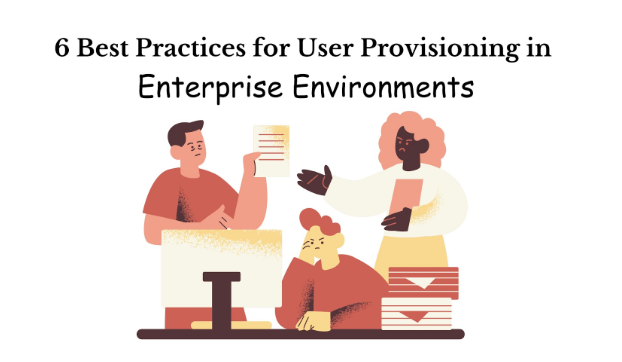6 Best Practices for User Provisioning in Enterprise Environments
How often have you received a message from Google asking, “Is this you logging in? If not, please disregard this email?”At a dinner party with friends, once Google sends you this email, almost everyone around you can sense that you are worried about the harm of having someone access your accounts, be it your Gmail, Facebook, or even your Twitter, where most of your emotions have piled up.
User provisioning enables IT professionals to detect, monitor, and control who is accessing your account, from what device they are accessing it, and the locations from which they are accessed. Cisco provisioning protects you, allowing only authorized devices and users to access your network.
The primary goal of provisioning tools is to protect and secure users, ensuring data compliance with privacy regulations.
Some of the Best Practices for User Provisioning:
1. Automatic Provisioning for Applications To Protect the User
Manually managing every account and checking all the credentials of users can be time-consuming and is a long process considering that an enterprise could have hundreds of employees. The IT team has to determine which access the new employees need or the existing employees could use to perform the scope of their job. Do they only need one-time access to a certain account? Or do they need complete and total access to it? Do they need one-way authentication or permanently signed in on the account? The best way to save time and effort is by employing provisioning automation.
Wondering how you can manage all of these tasks? A Provision Manager can help you sort out what has to be done and the considerations you need.
A provision manager assists with implementing technologies like user provisioning and can help manage end-user communication, including unified communication, and develop an appropriate support model for IT services.
2. Start Centralised Authentication
To see the current network of systems, look around and see the existing network. If the only group of people managing the software as a service application, cloud servers, providers, portals, databases, etc., is exhausting. It is prone to security. A centralized authentication allows the IT team to handle just one system where everything is stored and where authentication can be placed.
Enterprises must evolve with the times and utilize technology to its best extent. Centralized authentication is a top access management solution for enterprises, providing time efficiency for employees and the IT team.
3. Follow the Principle – Less Is More
Unfortunately, misuse of access by employees in certain positions isn’t unheard of, and it gets hard to stop those people from accessing the system as the IT team believes that they are higher than them. They could be their bosses. Such individuals might exploit their access to retrieve critical data. The mindset of hackers and cybercriminals is to target the system to which more people could have access; this is an entryway for them to start stealing data from databases and wreck the whole system. The ‘less is more’ principle suggests that fewer individuals with access lead to less data leakage, aligning with the goals of user provisioning.
This principle asserts that only those who need the data for their roles should have access. If they cannot perform their job, or their job entails data gathering inside the database, they are the only ones allowed to be in the system.
If you do not need it, you cannot have it.
4. Deprovisioning
Imagine walking into the mall and having someone mention details about your company’s clients, “Hey! I see that the company is doing well. So many clients!” It was all fun and games until you realized the person approaching you had resigned from the job. You are doomed.
Deprovisioning involves removing an individual’s access to the enterprise’s systems and accounts. This is a critical aspect to every organization as one failure to de-provisioned could subject the enterprise to a data breach or negligence, not to mention that hackers and cybercriminals could easily just access the database once the user’s account is hacked. Former employees who still retain access even after leaving are often termed ‘zombie accounts’ or ‘zombie employees.’
IT admins sometimes forget that employees resign from their jobs and that specific employee holds access to every account owned by the enterprise. It is said that the IT departments are one of those organizations that are busy and cannot put a hundred percent of their time into monitoring all the technology-related stuff, as well as employees coming and going.
5. Post Clear Guidelines and Criteria to Employees
Consider how pageants select top contestants based on set criteria. They have guidelines and criteria. One of an enterprise’s most underrated and overlooked actions when it comes to user provisioning is creating a set of criteria for employees to know if they are eligible to access the database or software. Enterprises should prioritize creating a checklist for new employees to understand their access rights to software and databases.
Providing transparency regarding the guidelines to obtain the accounts can simplify the user provision process and strengthen security as the principle ‘less is more’ is applied.
6. Provide Continuous Support to IT Department
The IT department is one of the core members of user provisioning; with their knowledge of computers and technologies, they can secure and manage data all at once.
While IT teams face a multitude of responsibilities, they remain committed, especially when it pertains to areas within their expertise. Enterprises should view the IT department as vital partners, ensuring that data remains secure. They should receive appropriate compensation and be equipped with the right tools to enhance their productivity, ensuring they can uphold the enterprise’s security, privacy, and confidentiality goals.
Conclusion
User provisioning is another way to ensure that the enterprise will be at no risk of a data breach. As an enterprise’s network continually evolves and advances like unified communication emerge, you must always consider the pros and cons of your technology. Keep in mind that the solution to the problems that technology can bring is the technology itself.
Well-established user provisioning saves time and shields your company from potential legal issues with clients. The win-win aspect of acquiring this outweighs the capital cost of having a team implement and monitor it.
Effective user provisioning focuses more on the proper implementation while protecting the enterprise and clients of the business.



